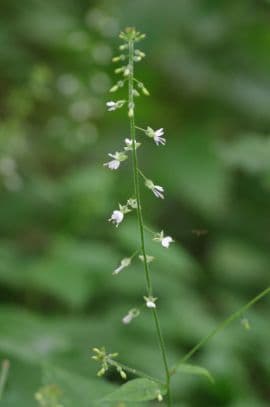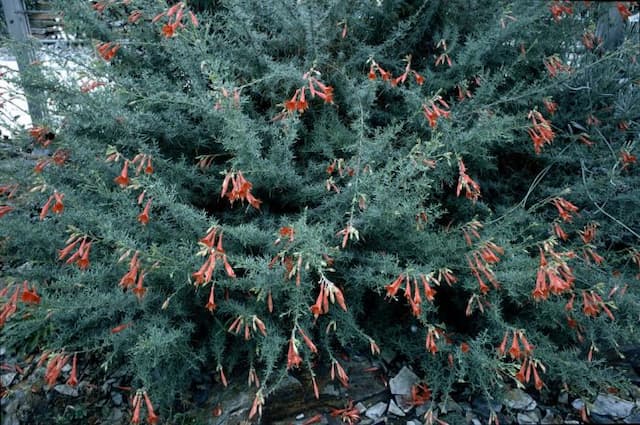Fuchsia Fuchsia 'Mrs Popple'

ABOUT
Fuchsia 'Mrs Popple' is a strikingly beautiful plant that stands out for its pendant, teardrop-shaped flowers. These blooms are a combination of deep purple and rich red hues. The outer petals are typically of a bright red color that gracefully curves backwards, while the inner petals, which are long and slender, display a vibrant purple color that sometimes seems to merge into the red. These two-toned flowers dangle from the branches like delicate ornaments and are complemented by long, protruding stamens. The blooms are known to attract hummingbirds and various pollinators. The foliage of 'Mrs Popple' is also quite attractive and provides a lush backdrop to the striking flowers. The leaves are generally a deep green, with a faint reddish tinge along the edges and the veins, which can be more pronounced in some specimens. They are oblong to oval-shaped, with a slightly serrated edge, and they are arranged oppositely along the branches. When in full bloom, Fuchsia 'Mrs Popple' creates a showy display that is both elegant and robust, making it a favorite among gardeners for adding a splash of vibrant color to the landscape.
About this plant
 Names
NamesFamily
Onagraceae
Synonyms
Lady's Eardrops, Fuchsia
Common names
Fuchsia 'Mrs Popple'.
 Toxicity
ToxicityTo humans
Fuchsia, including the 'Mrs Popple' variety, is generally considered non-toxic to humans. Therefore, ingestion of this plant typically does not lead to poisoning or serious health consequences. However, as with any plant, individual allergic reactions or sensitivities can occur, so it is advisable to avoid eating any plant material that is not known to be safe.
To pets
Fuchsia, including the 'Mrs Popple' variety, is typically non-toxic to pets as well. It is not known to cause serious illness or toxicity in animals if they ingest the plant. However, individual animals may have different sensitivities or reactions, and it is always a good practice to discourage pets from eating non-food plants to prevent any possible gastrointestinal upset or other mild reactions.
 Characteristics
CharacteristicsLife cycle
Perennials
Foliage type
Deciduous
Color of leaves
Green
Flower color
Mixed
Height
2-3 feet (60-90cm)
Spread
2-3 feet (60-90cm)
Plant type
Shrub
Hardiness zones
6-9
Native area
Central and South America
Benefits
 General Benefits
General Benefits- Attractive Flowers: Fuchsia 'Mrs Popple' produces beautiful pendulous flowers that are a vivid combination of red and purple, adding a splash of color to any garden.
- Pollinator Friendly: The plant attracts hummingbirds, bees, and other pollinators, which are essential for the pollination of many plants and the overall health of the ecosystem.
- Long Blooming Season: It typically has a long flowering period that spans from late spring to early fall, providing a long-lasting display of its ornamental blooms.
- Versatile Planting: Suitable for containers, hanging baskets, and flower beds, offering flexibility in garden design and placement.
- Shade Tolerance: Unlike many flowering plants, Fuchsia 'Mrs Popple' can thrive in partial shade, making it ideal for planting in various light conditions.
- Easy Propagation: It can be easily propagated by cuttings, allowing gardeners to create more plants for their garden or to share with others.
- Garden Structure: The bushes of Fuchsia 'Mrs Popple' can add structure and height to your garden beds and borders.
- Minimal Pests and Diseases: It often has few problems with pests and diseases, making it an easier plant for gardeners to maintain.
 Medical Properties
Medical PropertiesThis plant is not used for medical purposes.
 Air-purifying Qualities
Air-purifying QualitiesThis plant is not specifically known for air purifying qualities.
 Other Uses
Other Uses- Fuchsia 'Mrs Popple' can be used in hanging baskets to create cascades of downward-hanging flowers, providing a dramatic display of color.
- The plant can be trained to grow as a standard, giving the appearance of a small tree with a rounded top full of vibrant blooms.
- Fuchsia flowers are edible and can be used as a colorful garnish in salads, desserts, or cocktails for an exotic touch.
- They can serve as a natural dye, lending their color to fabrics, though the results will vary with the mordant used.
- Certain parts of the plant, like the berries, can be used in jam-making, offering a unique flavor profile to homemade preserves.
- Pressed fuchsia flowers can be used in crafting, such as in making bookmarks, greeting cards or decoupage projects.
- The plant's dense foliage can provide shelter for small garden wildlife like insects and frogs, enhancing biodiversity.
- Dried flowers and foliage from Fuchsia 'Mrs Popple' can be incorporated into potpourri blends for a decorative and fragrant addition to a room.
- Some artisans use the wood from pruned fuchsia branches in small-scale woodworking projects like making handles for tools or as inclusions in resin jewelry.
- Photographers and artists often use fuchsia plants as subjects or backdrops due to their striking color and form, making them ideal for botanical artistry.
Interesting Facts
 Feng Shui
Feng ShuiThe Fuchsia is not used in Feng Shui practice.
 Zodiac Sign Compitability
Zodiac Sign CompitabilityThe Fuchsia is not used in astrology practice.
 Plant Symbolism
Plant Symbolism- Good Taste - Fuchsia 'Mrs Popple' flowers are known for their elegant, drooping teardrop shape which is often associated with refinement and good judgment in aesthetics.
- Overflowing Abundance - The plant often produces an abundant number of flowers which symbolizes generosity and a wealth of blessings or emotions.
- Confiding Love - With a delicate appearance yet a hardy nature, fuchsias are thought to represent a deep love that is sensitive but enduring.
- Trustworthy - Fuchsia 'Mrs Popple' is a reliable bloomer in suitable climates, representing faithfulness and dependability.
- Warmth and Humility - The warmth of its vibrant colors combined with its graceful hanging flowers can symbolize a kind and modest disposition.
 Water
WaterFuchsia 'Mrs Popple', commonly known as hardy fuchsia, requires evenly moist soil and does not like to dry out. Provide the hardy fuchsia with about one inch of water per week, adjusting for rainfall and temperatures. Water deeply to ensure that the water penetrates the root zone; shallow watering encourages weak root systems. During hot spells or if you notice the leaves drooping, you may need to water more frequently. In containers, check the soil moisture daily and water as needed, ensuring proper drainage to prevent waterlogged conditions.
 Light
LightHardy fuchsia thrives in partial shade to dappled sunlight. It does its best when protected from the harsh midday sun, especially in hotter climates. An ideal location would be where the plant receives morning sunlight and afternoon shade, as intense afternoon sun can stress the plant and cause leaf scorch.
 Temperature
TemperatureHardy fuchsia prefers a cool to moderate climate with temperatures ranging between 60 and 75 degrees Fahrenheit. The minimum temperature it can withstand is around 25 degrees Fahrenheit before it risks cold damage. In areas with very hot summers, it is important to keep the plant in a location where it can enjoy cooler temperatures, particularly in the evening.
 Pruning
PruningPruning hardy fuchsia helps to maintain its shape, encourage bushier growth, and remove dead or diseased branches. Prune in late winter or early spring before new growth begins. Remove any old wood that isn’t producing new shoots and trim back about a third of the plant to promote vigorous, healthy growth. Deadheading spent flowers during the blooming season will also encourage more blooms.
 Cleaning
CleaningAs needed
 Soil
SoilFuchsia 'Mrs Popple', commonly called Hardy Fuchsia, thrives in a soil mix consisting of one part peat moss, one part loam, and one part perlite or sand to ensure good drainage. The soil pH should ideally be around 6.0 to 7.0 for optimal growth.
 Repotting
RepottingHardy Fuchsia should be repotted every two to three years, ideally in spring. Younger plants may need to be repotted annually if they're growing rapidly.
 Humidity & Misting
Humidity & MistingHardy Fuchsia prefers high humidity levels, typically between 60-70%, which helps support its lush foliage and blooming habit.
 Suitable locations
Suitable locationsIndoor
Place in bright, indirect light away from heaters.
Outdoor
Part shade, sheltered from wind, moist well-drained soil.
Hardiness zone
6-9 USDA.
 Life cycle
Life cycleFuchsia 'Mrs Popple' begins its life cycle with seed germination, typically in a warm and humid environment, and then progresses to the seedling stage, where the first leaves develop. As it grows, the plant enters its vegetative phase, producing stems and foliage while becoming established. It then matures into the flowering stage, where the distinctive red and purple flowers appear and are pollinated, either by insects or through human intervention. After pollination, it produces fruits, within which seeds develop, completing the cycle. In colder climates, fuchsias will go through a period of dormancy during the winter, if they are not grown as annuals and are able to survive the frosts. Upon spring's arrival, the cycle begins anew with fresh growth from overwintered plants or germination of fallen seeds.
 Propogation
PropogationPropogation time
Spring-Early Summer
The Fuchsia 'Mrs Popple', commonly known as Hardy Fuchsia, is best propagated through softwood cuttings during the spring or early summer when the plant is actively growing. To do this, select a healthy stem with several leaves and cut a piece about 4 to 6 inches (10 to 15 cm) in length just below a leaf node. Strip the lower leaves off, leaving a couple at the top, and dip the cut end in rooting hormone powder to encourage root growth. Plant the cutting in a moist, well-draining potting mix, taking care not to let the leaves touch the soil to prevent rotting. Cover the cutting with a plastic bag or place it in a propagator to maintain high humidity, and keep it in a warm, bright space out of direct sunlight. In a few weeks, once roots have formed and new growth is evident, the cutting can be transplanted into a larger pot and gradually acclimatized to outside conditions if weather permits.









